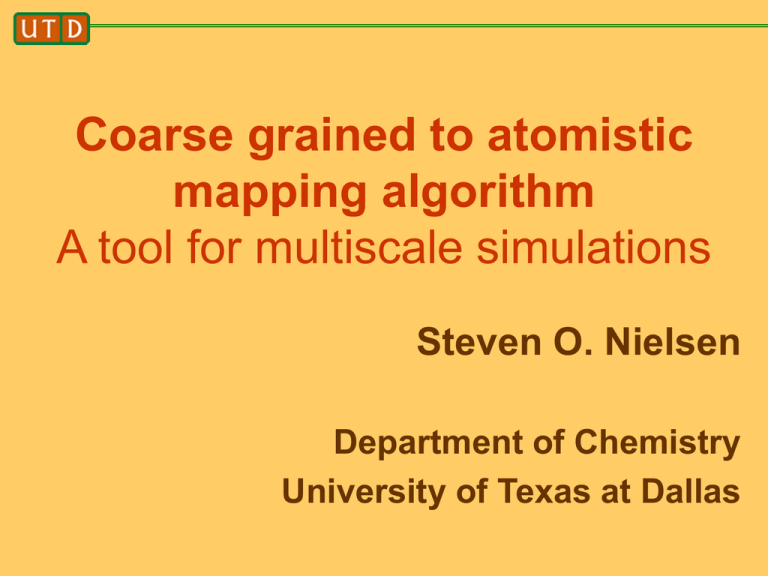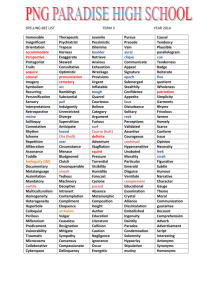Coarse grained to atomistic mapping algorithm A tool for multiscale simulations
advertisement

Coarse grained to atomistic mapping algorithm A tool for multiscale simulations Steven O. Nielsen Department of Chemistry University of Texas at Dallas Outline • Role of inverse mapping in – Multiscale simulations – Validation of coarse grained (CG) models – CG force field development • • • • • Schematic picture Some mathematical details Application to molecular systems Illustrative example : bulk dodecane Conclusions Coarse grained strategies for aqueous surfactant adsorption onto hydrophobic solids Spatial / Temporal scales in computational modeling C.M. Shephard, Biochem. J., 370, 233, 2003. Validation of CG models a S.O. Nielsen e al., J. Phys.:Condens. Matter., 16, R481, 2004. Multi-scale simulations Coarse grain Atomistic Wholesale mapping Mixed CG/AA representation On-the-fly mapping Automated CG force field construction Can switch back and forth repeatedly and refine the coarse grain potentials by force matching or other algorithms. Idea: rotate frozen library structures T M T M Library structures from simulated annealing atomistic MD T M T= M M= At every point R0 on the manifold SO(3) we construct a continuous, differentiable mapping between a neighborhood of R0 on the manifold and an open set in R3 R( ) R0 exp J ( ) where 0 J ( ) z y The objective (energy) function can be expanded to quadratic order about R0 z 0 x R , 3 y x 0 OR OR0 g t t H and the conjugate gradient incremental step is s H 1 g Computationally efficient algorithm because of the special relationship between SO(3) and the group of unit quaternions Sp(1) q (cos , ˆ sin ) , 12 Updated rotation is obtained by quaternion multiplication q0qs. The other source of efficiency comes from working at the coarser level: there are only three variables (one rotation matrix) per coarse grained site. Minimize an energy function C H H C H H H C H C H H • interactions are only between atoms belonging to different coarse grained units – – – – Bonds Bends Torsions, 1-4 Non-bonded (intermolecular and within the same long-chain molecule) Bond O( R1 , R2 ) k ( r R 2 v R1u d0 ) 1 2 u COM 1 2 v r Need to compute the gradient ( r R2v R1u d 0 ) Os k (r R2v R1u ) R1u O r R2v R1u x1 x1x1 x1 R1u R01 J ( xˆ ) u COM 2 Bend O( R1 , R2 ) k ( 0 ) 1 2 2 ( R1u R1u ) (r R2v R1u ) arccos R1u R1u r R2v R1u u’ COM 1 v u r COM 2 Coarse grain to atomistic mapping Optimized library structure from a simulated annealing atomistic MD run Anticipate performing the inverse mapping at each coarse grain time step. The SO(3) conjugate gradient method should be efficient this way because each subsequent time step is close to optimized. One molecule of dodecane Minimize over SO(3) with fixed center of mass liquid C H H C H 20 dodecane molecules shown in a box of 1050 molecules (bulk density = 0.74 g/mL) H H C H Energy function consists of: • 1 bond, 4 bends, 4 torsions, and 4 one-fours per “join” between intramolecular CG sites • All L-J repulsions between H atoms Taken directly from the CHARMM force field Single snapshot – fully converged Calculate the fully atomistic CHARMM energy on the SO(3) converged structure From the equipartition theorem, expect to have ½ kT energy per degree of freedom: Bonds T = 294 K Bends T = 1125 K Torsions T = 75 K One-fours T = 97 K 100 consecutive CG frames with incremental updating Very fine convergence tolerance Final structure equipartition estimate: Bonds T = 316 K Bends T = 1002 K Torsions T = 79 K One-fours T = 247 K Conclusions • The coarse grained to atomistic mapping algorithm presented here uses SO(3) optimization to align optimized molecular fragments corresponding to coarse grained sites • The algorithm’s efficiency comes from using quaternion arithmetic and from optimizing at the coarse grained level • The mapping algorithm will play an important role in multiscale simulations and in the development and validation of coarse grained force fields. SDS Solubilization of Single-Wall Carbon Nanotubes in Water C. Mioskowski, Science 300, 775 (2003) M. F. Islam et. al., Nano Lett. 3, 269 (2003) Smalley – Science 297, 593 (2002) Islam -- Would explain difference between SDS and NaDDBS JACS 126, 9902 (2004): SANS data JACS 126 9902 (2004) Strategy 1) Derive an effective interaction between a liquid particle and the entire solid object 2) Coarse grain the liquid particles 1) 2) 1) 2) 1) Is an old idea from colloid science : Hammaker summation My contribution : Phys. Rev. Lett. 94, 228301 (2005) and J. Chem. Phys. 123, 124907 (2005) 2) Fundamental idea: two non-interacting particles P ( z1 , z2 ) e P ( z1 z2 2 z ) (2 z ) 1 2z e U ( z1 ) U ( z2 ) e U ( z1 ) U ( 2 z z1 ) e 0 The probability density and the potential are related by [normalization convention follows g(r)] P e U dz1 Two interacting particles P ( z1 , z2 ) e U ( z1 ) U ( z2 ) e PI ( z1 , z2 ) PI doesn’t involve the surface. Can be obtained from liquid simulations. The probability of the center of mass being at height z is given by: P ( z1 z2 2 z) 2z 0 e U ( z1 ) U ( 2 z z1 ) e 2z 0 PI ( z1 ,2 z z1 ) dz1 PI ( z1 ,2 z z1 ) dz1 where the normalization constant is the numerator with U = 0, namely with no surface. Nanoscale organization: Experimental observation Surfactant C10E3 C12E5 ethylene oxide units 3 5 C12E5 on graphite AFM images Schematic illustration L. M. Grant et. al. J. Phys. Chem. B 102, 4288 (1998) alkyl chain length 10 12 Structure monolayer hemi-spheres C10E3 on graphite Snapshots of C12E5 Self-Assembly on Graphite Surface t=0ns t=0.64ns t=3.3ns d=5.0 nm t=3.75ns t=4.3ns t=6.0ns Extension to curved surfaces Theory for cylinders and spheres is done. Applications are being carried out for the solubilization of carbon nanotubes and for the (colloidal) solubilization of quantum dots Triton X-100 adsorbing on carbon nanotube Acknowledgements • Bernd Ensing (ETH Zurich) • Preston B. Moore (USP, Philadelphia) • Michael L. Klein (U. Penn.) Funding National Institutes of Health



